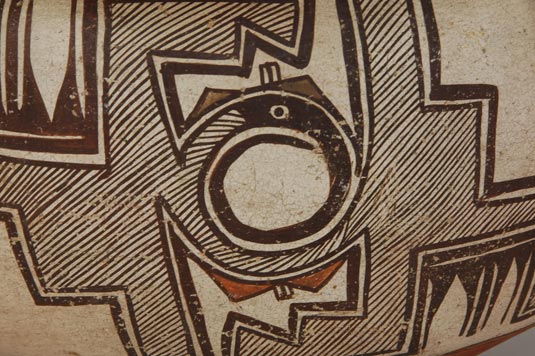Zuni Pueblo Polychrome Jar with Rain Bird Design [SOLD]
+ Add to my watchlist Forward to Friend
- Category: Historic
- Origin: Zuni Pueblo, SHE-WE-NA
- Medium: clay, pigment
- Size: 9-1/4” tall x 13-1/2” diameter
- Item # C3504C SOLD
Zuni Pueblo jars of the style of this one were apparently made earlier than 1875 and continued being made after 1900. The main body design was named a Rain Bird by H. P. Mera who published a comprehensive study of this design in 1938. It appears that almost every single jar with this design is quite similar. Most documented jars with the design date to circa 1875 or earlier. This jar, with a red underbody, could date to as early as 1865.
Mera states that if one “Upon viewing, for the first time, a large collection of Pueblo pottery of the historic period gathered from the various villages where the art of the potter has been perpetuated for the last three centuries, one is very likely to be impressed by the seemingly endless variety of design. A more critical study, however, discloses the fact that in reality astonishingly few basic elements were employed to produce complex design structures.” His point is well taken on jars with the Rain Bird design. As complicated as they seem, most are almost identical.
Mera further states that the Rain Bird design had its beginnings back to the early centuries of the Christian era. These earlier designs were rudimentary but one can see the beginnings of fine line elements with little attempt at organization. As time progressed, to a thousand years later, these random designs began to assume more semblance of order. Eventually, the distal ends of straight lines began to curve, eventually leading to the volutes we see today in Zuni pottery.
It has been proved that the Tularosa people were ancestral to those of Zuni, but few elements from Tularosa pottery show up in historic Zuni wares except the curved elements of the head of the Rain Bird. It is speculated that the use today of ancestral designs was and is an attempt to perpetuate a connection to tradition, first for ceremonial use, then later considered proper for secular use jars.
The head of the Rain Bird is capped by a pair of red triangles. The beak is dark brown and a circle represents the eye of the bird. The body is a zigzag elongated device filled with black parallel fine lines. There are three of these birds surrounding the body of the jar. The body of the bird is outlined in a narrow black line which is then outlined in a darker black line. This is very typical on most of the Rain Bird jars. The neck design is a more stylized presentation of the beak of the bird or what is usually referred to as a volute. The under body is painted red, a color that essentially began to give way to black around 1865. There is a small curve at the rim of the jar and the rim is painted black.
Condition: remarkable condition for its age. No evidence of repair or restoration
Provenance: from the collection of a family from New York who displayed it in their Santa Fe residence.
References: The “Rain Bird” A Study in Pueblo Design by H. P. Mera
The Pottery of Zuni Pueblo by Harlow and Lanman

- Category: Historic
- Origin: Zuni Pueblo, SHE-WE-NA
- Medium: clay, pigment
- Size: 9-1/4” tall x 13-1/2” diameter
- Item # C3504C SOLD



